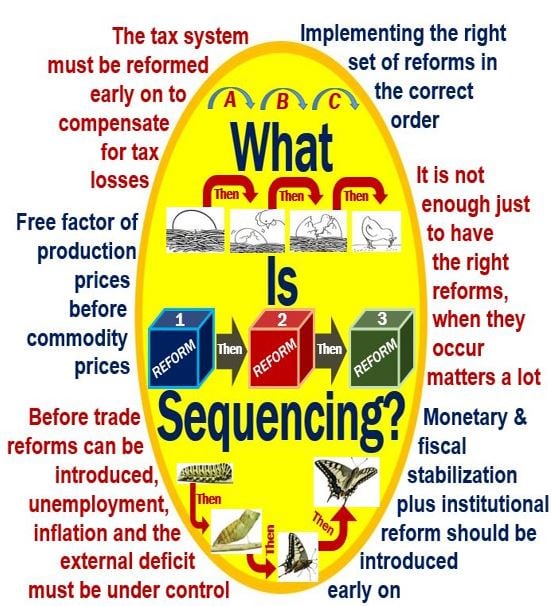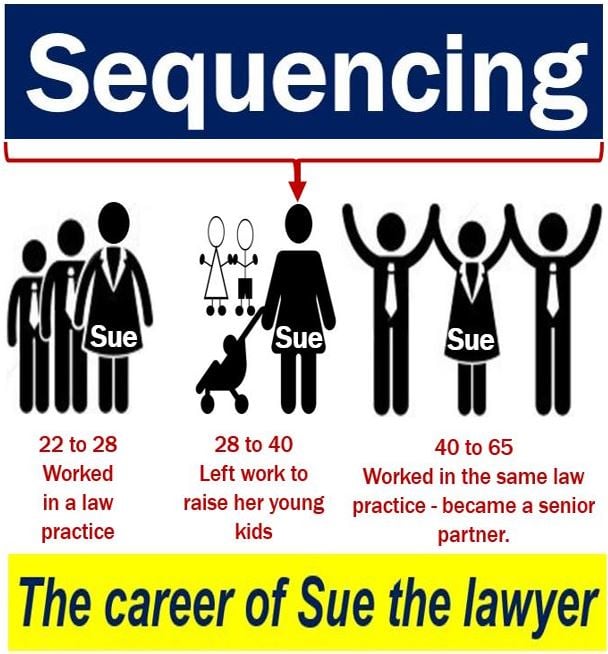What is sequencing? Definition and meaning
Sequencing refers to the implementation of economic reforms to revive an economy that is not working properly, specifically, sequencing is all about introducing them in the right order. When an economy malfunctions, it is not enough to simply introduce the right policies, say some economists – they need to come in the right sequence and the correct pace. Over the past couple of decades, sequencing and pace have become popular topics in development economics.
Sequencing may also refer to the interruption of a woman’s career to bear children and take care of them until they reach an age that allows her to return to the workplace.
In the world of genetics research, DNA sequencing is the process of determining the exact order of nucleotides or bases within a DNA molecule – the order of As, Cs, Gs and Ts that make up the DNA of an organism.
This article concentrates on sequencing’s meaning when it refers to economic reforms that need to be introduced into a country’s malfunctioning economy.
 When talking about economic reform, sequencing refers to introducing the new strategies in the right order.
When talking about economic reform, sequencing refers to introducing the new strategies in the right order.
Regarding sequencing, the Economist’s glossary of terms says the following:
“Shorthand for implementing economic reforms in the right order. In recent years, this has become a hot topic in development economics. Some economists argue that introducing the right policies alone is not enough to revive a malfunctioning economy; reforms must be implemented in the right sequence.”
The debate on sequencing began in the late 1970s with the reforms of Latin American economies. After several failed attempts at reforming malfunctioning economies, academics and policymakers began debating whether the problems were the contents of the reforms themselves or the order in which they were implemented – sequencing.
The majority of economists agree that fiscal and monetary stabilization, and institutional changes should be introduced early on in the reform process.
There is less agreement on the timing of the other reform areas, in particular when to focus on the financial sector, trade, and capital account liberalization.
In a 20002 IMF (International Monetary Fund) paper – The Speed of Adjustment and the Sequencing of Economic Reforms – Norbert Funke, Mounir Rached, and Saleh M. Nsouli explained that over the last several decades, observers of internationally supported adjustments programs have disagreed more on the sequence and pace of reform packages than their content.
 According to Dictionary.com, sequencing can mean: “The interruption of a career by a woman to bear and care for children until they reach an age that allows her to resume work.” The woman who does this is sometimes referred to as ‘a sequencer’.
According to Dictionary.com, sequencing can mean: “The interruption of a career by a woman to bear and care for children until they reach an age that allows her to resume work.” The woman who does this is sometimes referred to as ‘a sequencer’.
In the same paper, the authors defined sequencing as follows:
“The sequencing of reforms refers to the order in which either macroeconomic policy actions or specific reforms are introduced.”
“Sequencing involves the order in which reforms are undertaken across sectors – for example, whether fiscal adjustment or stabilization should be a prerequisite for introducing current account liberalization or decontrolling prices – and the order in which reforms are undertaken within sectors – for example, whether in the case of capital account liberalization, foreign direct investment or short-term capital flows should be liberalized first.”
The speed of adjustment, the authors emphasized, will be influenced by the sequencing across and within sectors, and the extent that it needs time.
A large number of economists are not convinced by these arguments, and wonder whether there really is a right sequence.
Appropriately sequenced reforms
In its 2015 Economic Update for Belarus, the World Bank argued that appropriately-sequenced reforms could boost economic growth over the long-term and address long-standing structural inefficiencies.
According to the World Bank, Belarus needs extensive institutional changes that can support innovation, positively affect enterprise performance, and help open new markets for the country’s products and services.
Before trying to stimulate demand, the Belarus authorities are allowing for the required macroeconomic adjustment to run its course.
Even though the country’s current account deficit is narrowing due to lower demand for imported goods and services, considerable external financing is required to meet large foreign debt repayments.
 In an article titled – ‘DNA Sequencing’ – The National Human Genome Research Institute in the United States explains: “The sequence tells scientists the kind of genetic information that is carried in a particular DNA segment. For example, scientists can use sequence information to determine which stretches of DNA contain genes and which stretches carry regulatory instructions, turning genes on or off. In addition, and importantly, sequence data can highlight changes in a gene that may cause disease.” (Image: adapted from genome.gov)
In an article titled – ‘DNA Sequencing’ – The National Human Genome Research Institute in the United States explains: “The sequence tells scientists the kind of genetic information that is carried in a particular DNA segment. For example, scientists can use sequence information to determine which stretches of DNA contain genes and which stretches carry regulatory instructions, turning genes on or off. In addition, and importantly, sequence data can highlight changes in a gene that may cause disease.” (Image: adapted from genome.gov)
Regarding sequencing – having appropriate reforms implemented in the right order – Ruslan Piontkivsky, World Bank Senior Economist, wrote:
“‘Export diversification is naturally an important objective when demand in traditional markets is declining, but Belarusian companies will have to quickly acquire new competencies in market entry and export product development.”
“As the Government is accelerating its negotiations with the WTO, it is critical to put in place an effective adaptation and support strategy that will build knowledge about new world markets, enhance competitiveness, and product appeal to consumers. With the eventual WTO accession, Belarus must do all it can to take full advantage of more open market access.”
Video – India’s economic reforms
In 1991, India began its journey of transformation from being a closed, socialist economy to an open internationally-trading one. The country went through the following sequencing reform path: 1. Liberalization. 2. Privatization. 3. Globalization.
Indians aged up to thirty years are unaware, unless their parents and older relatives tell them, how much easier it is today to purchase a smartphone or any kind of communications device compared to 26 years ago. Before 1991, you would need to get permission from various authorities to be able to buy a simple conferencing facility.

